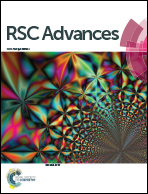Nano Fe3O4 supported biimidazole Cu(i) complex as a retrievable catalyst for the synthesis of imidazo[1,2-a]pyridines in aqueous medium†
Abstract
A novel magnetically recoverable nano-catalyst based on a biimidazole Cu(I) complex has been synthesized by covalent grafting of biimidazole on chloride-functionalized silica@magnetite nanoparticles, followed by metalation with CuI. The synthesized catalyst was characterized by various techniques such as CHN, NMR, FT-IR, TG/DTG, SEM, TEM, EDS, XRD, AAS, ICP-OES and VSM which revealed the superparamagnetic nature of the particles. The amount of Cu in the catalyst was measured to be 1.2 mmol g−1 by ICP-OES and AAS. From electron microscopy (SEM and TEM) studies it can be inferred that the particles are mostly spherical in shape and have an average size of 20 nm. Elemental and thermo gravimetric analysis (CHN and TG) results indicate the loading amount of functionalized organic groups on the magnetic material was 1.4 mmol g−1. The prepared nanocatalyst was shown to have excellent and green catalytic activity in the synthesis of imidazo[1,2-a]pyridines in aqueous media. The catalyst can be easily recovered by applying an external magnetic field and reused for atleast 10 times without deterioration in catalytic activity.
![Graphical abstract: Nano Fe3O4 supported biimidazole Cu(i) complex as a retrievable catalyst for the synthesis of imidazo[1,2-a]pyridines in aqueous medium](/en/Image/Get?imageInfo.ImageType=GA&imageInfo.ImageIdentifier.ManuscriptID=C4RA03333G&imageInfo.ImageIdentifier.Year=2014)

 Please wait while we load your content...
Please wait while we load your content...